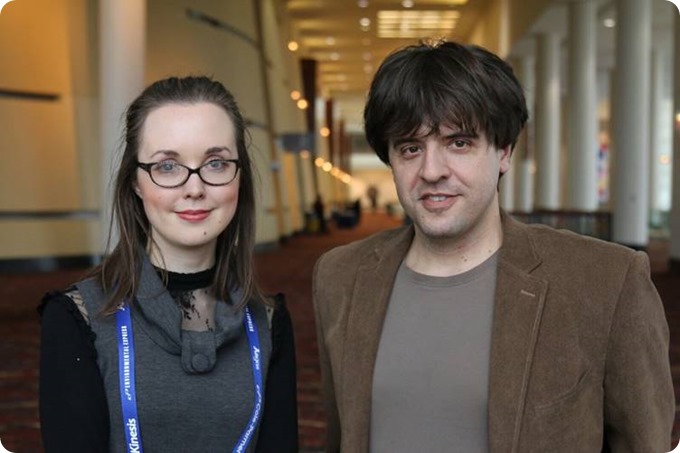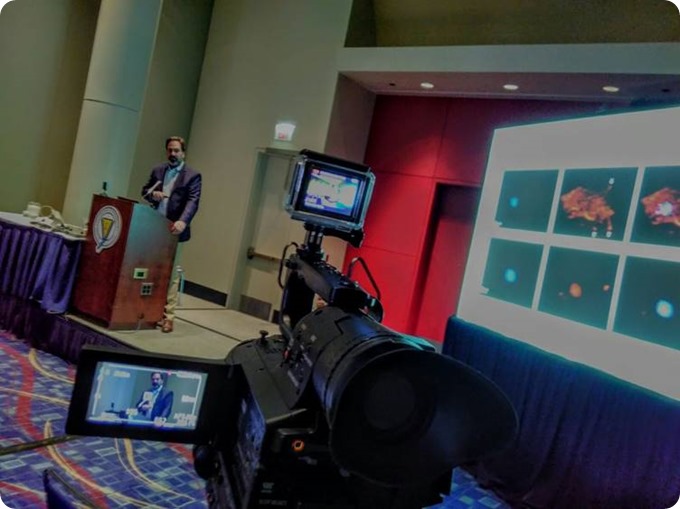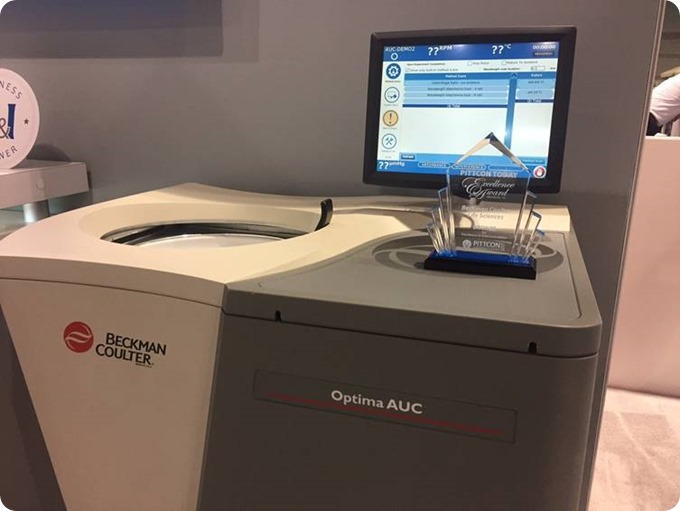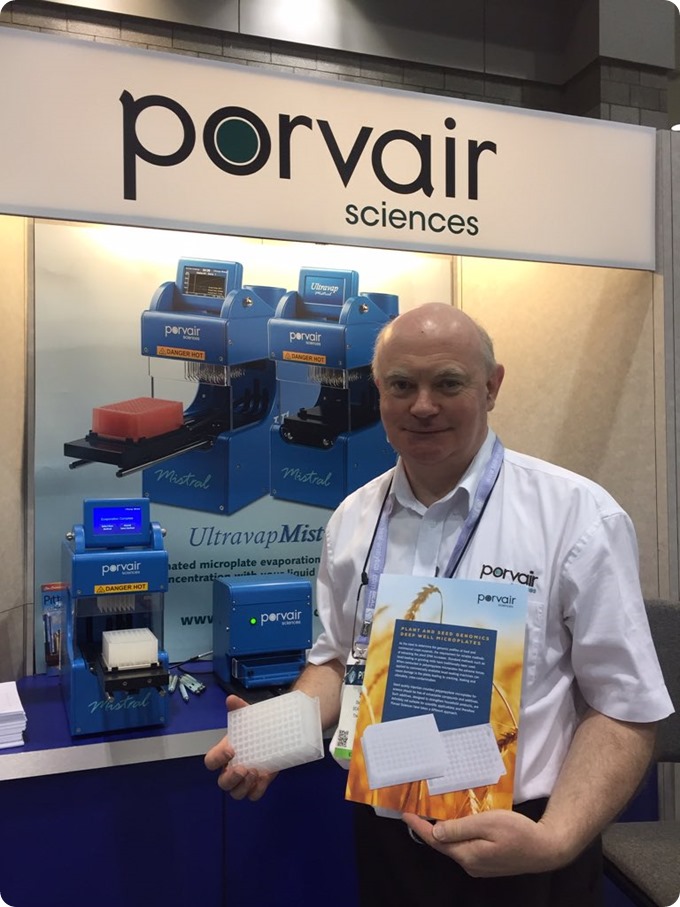Pittcon 2017 commenced with a fascinating talk by world-renowned optogenetics expert Dr. Karl Deisseroth, D.H. Chen Professor of Bioengineering, Psychiatry and Behavioral Sciences, Stanford University and Investigator of the Howard Hughes Medical Institute.
Optogenetics allows neuroscientists to play in information to the brain by using light to target specific cells. The technique overcomes the challenges of observations and correlations and enables the ability to address causality.
Dr Deisseroth outlined emerging insight into how optogenetic proteins work and how his team are building new optogenetic approaches based on this deeper understanding.

Dr. Karl Deisseroth (right) and April Cashin-Garbutt (left)
The depth of knowledge now achievable was a theme that continued throughout Pittcon. Thermo Fisher Scientific described their focus on allowing users to go from sample to knowledge in order to make the world a healthier, cleaner and safer place.
In addition to mass spectroscopy and their newly obtained strength in electron microscopy, through the recent acquisition of FEI, Thermo Fisher Scientific announced at Pittcon the expansion of their informatics capabilities to help customers turn data into actionable knowledge.
Data of course plays a large role in many areas of science including genomics. The Twenty-Eighth Annual Waters Symposium at Pittcon 2017 focused on the advances in genomic analysis technologies. Speakers included Professor David Walt, Scientific Founder of Illumina, Inc., and also Jay Flatley, Executive Chairman and previously President and CEO of Illumina, Inc. The Waters Symposium recognized the history, science, and applications of the technologies developed by Illumina, Inc.
In his second talk, which took place on 8 March, Professor Walt focused on the single molecule array (Simoa) technology and how it has been applied to the analysis of cultured cancer cells.

Dr Chad Mirkin giving a talk at Pittcon 2017
Advances in cancer research were also described by Dr. Chad Mirkin who spoke of the therapeutic potential of spherical nucleic acids as potent immunomodulation agents for cancer therapy and the development of cancer vaccines.
Dr. Mirkin explained the exciting phenomenon of the internalization of spherical nucleic acids into cells via scavenger receptors and how they recognize and bind much more tightly than linear nucleic acids. It is hoped that the cancer vaccine will go into human clinical trials later this year.
The pharmaceutical market was also a big focus for Bruker this year who showcased a selection of innovative high-performance systems and high-value analytical solutions at Pittcon including the exciting new MALDI PharmaPulse 2.0 system that enables pharmaceutical label-free ultra-high throughput screening (UHTS) for primary screens of millions of compounds at significantly lower cost.
Frank H. Laukien, Ph.D., the Bruker President and CEO, explained how the new system can measure up to 10 different samples per second, a 100- to 1000-fold increase in speed and throughput for mass spectrometry-based, label-free screening, with seamless integration into third-party UHTS robotics solutions.
Professor Jonathan Sweedler, University of Illinois at Urbana-Champaign, also described how MALDI can be used to perform single cell profiling at high-throughput enabling the analysis of 10,000 cells at a time. During his talk he explained how they take a sample from a brain region and use this approach to probe the neuropeptides and some of the lipids and small molecules in those cells. Following the high-throughput profiling, other techniques can then be used to learn more about the rare cells.
Many high-throughput systems could also be found at the Pittcon 2017 exhibition including the award-winning analytical ultracentrifuge, the Optima AUC, from Beckman Coulter Life Sciences, which enables macromolecular characterization in solution and delivers up to 7 samples in a single run.

Beckman Coulter Life Sciences’ award-winning Optima AUC at Pittcon 2017
Neutec Group Inc. showcased their multispectral imaging system VideometerLab 4, which can measure color, texture, shape, size, orientation and gloss, providing product and process information in many areas. Applications include pharmaceutical screening for contamination; forensic analysis and microbiological culture monitoring and automation.
Automation was also another common theme and Vitl Life Science Solutions exhibited several of their products including the Ther-Mix heated mixer, which allows users to store up to 100 mixing programs with multiple heating and mixing steps.

Steve Knight at Porvair Sciences
Porvair Sciences were demoing their new Autocapper, a versatile electronic applicator that enables friction sample seals to be quickly and securely applied to both microplates and microtube racks. They also showcased their genomics plates with reinforced ribs to avoid contamination.
Overcoming contamination was also a theme for MilliporeSigma who announced the global launch of the seventh-generation Milli-Q® water purification innovation, which marks the 50th anniversary of their first water purification system.
Contamination detection was also covered by Bob Clifford, General Manager for Shimadzu, who described the challenges of analyzing both contamination and potency in cannabis. To help tackle these challenges Shimadzu have announced the launch of the new Cannabis Analyzer for Potency.
Overall there were many great talks and symposiums at Pittcon this year, a wealth of analytical solutions on show at the exhibition and the conference will return next year in Orlando, Florida Feb. 26 – Mar. 1, 2018.
What Pittcon Can do for You
What Pittcon Can do for You from AZoNetwork on Vimeo.